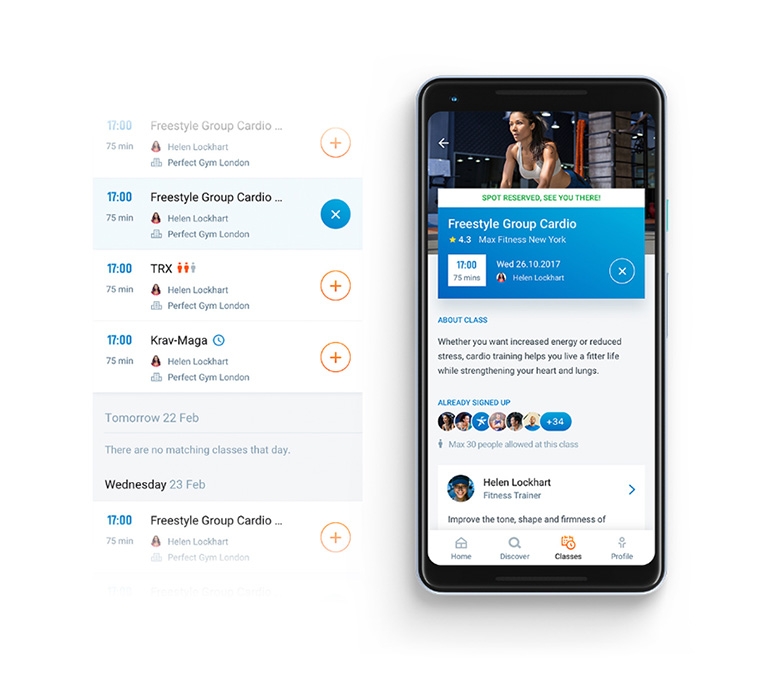

The fitness industry has lucrative potential —the global health and fitness club market is projected to grow at a rate of 10.6% from 2018 to 2023. At the height of the pandemic, a single UK-based fitness app garnered over one million downloads—signalling the societal change towards health and wellness.
If you’re a fitness junkie, you already enjoy breaking a sweat. Now the real work begins. In this article, we’re going to show you everything you need to know about how to start a fitness business.
What is a fitness business, and why start one yourself?
A fitness business is a facility or service for paying customers. A fitness facility can be more easily understood when split into two categories: traditional big-box gyms like Gold’s Gym or group-fitness-focused studios like Pure Barre. Whereas, a fitness service covers a wide array of services related to the fitness industry. For the purpose of this article, we will look at the fitness industry as a whole.
Although lockdown ignited an improved commitment to health and fitness, it was also responsible for a seismic shift away from traditional gym environments. The health and wellness industry is overflowing with opportunities for creative entrepreneurs with a fitness background to help others achieve their personal goals. Innovative, fitness-orientated individuals are discovering engaging and exciting ways to further their business and achieve a balance of body and mind.
Ideas for a successful fitness business in a post-pandemic climate
When public places were restricted in 2020, 80% of consumers tried live stream workouts, up from only 7% in 2019. Virtual fitness classes suddenly became mainstream, and the global population slowly embraced the stay-at-home approach.
A recent survey of millennials and Gen Zers confirmed that they now prefer at-home to gym-based workouts ( 81% and 50%, respectively). These results indicate that personal trainers have an excellent opportunity to reach fitness-minded clients in these generations (born between 1981-2015; that’s ages 6-40) at home, where they most prefer to work out.
Besides the peace of mind to maintain safe social distancing, outdoor exercise stimulates the senses. At the start of 2021, outdoor exercise was expected to be the year’s top fitness trend, with 51.9% of active adults opting for open-air activities instead of only 14.6% one year earlier. Deciding to start an outdoor fitness group is great as the operational costs are significantly reduced (you don't have to pay for space in a park).

People are spending more time inside these days, and that means more screen time. It’s never been a better time to profit from the power of the internet. A fitness enthusiast who is also great with a pen (or keyboard) can find that maintaining a blog that focuses on health and wellness can be a very fulfilling and profitable business. Why not even start your own podcast?
If you are passionate about fashion, the fitness apparel industry is experiencing explosive growth and is expected to reach a market value of $248.1 billion by 2026. Sub-categories including yoga-inspired clothing, sustainability, size inclusivity, customisation and wearable technology are all trending and will account for significant sales in a category already dominating global sales. Starting a fitness apparel online shop could be worth considering.

Similarly, if you come from a sales background or are a marketer at heart, nutritional supplements are a great small business to consider. The fitness supplement market experienced sustained, double-digit growth in 2020, as COVID-19 incentivised better health and nutrition. For instance, the US market is valued at $140 billion and is anticipated to grow 8% through 2028.
These are just a few fitness business ideas you can consider getting into.
11 steps on how to start a fitness business
A successful fitness business is focused on delivering valuable services, professional instruction, and engaging personal training. However, starting a fitness business requires a lot more than that. Here are 12 steps on how to start a fitness business journey:
#1: Understand your competition
Do some research to understand what the competitors in your field are offering. It might pay to do some local surveys to gauge the trending fitness offerings where you live or wider internet-based surveys to gauge what your targeted client is interested in. Identify what kind of regimes or products are popular and what gaps are there in the fitness industry.
Understand how they do business, what sets them apart and what internal tools they implement to make their business run smoothly.
#2: Decide on your niche
Before you immerse yourself in starting a fitness business, you’ll need to establish your speciality and fine-tune your brand. What’s your fitness aspiration? Are you interested in becoming a personal trainer? Maybe a fitness influencer? Have ambitions to run a boutique fitness studio? Whichever direction you choose, you’ll need to obtain the proper certifications and knowledge to validate your authority.
Once you’ve pinpointed your niche, research it as if your life depended on it (it might). Acknowledge your target demographic, and don’t forget your competition. Your competition is both local and virtual, so don’t limit your competitive research to your physical location. You’ll need to develop your fitness brand from all angles to stand out in a saturated wellness space.

#3: Educate yourself
If your competitors have a high level of training or knowledge, you will need to match them to stay competitive. If your competitors suffer from a lack of training or knowledge, you can set yourself apart with additional up-skilling. Whilst conducting market research identify the missing pieces in the fitness industry and the latest trends that no one is talking about? These could be the newest supplements, latest exercises or eco-friendly appeal brands.
Whether you want to know how to start a fitness business or manage a gym, you really should have some background in fitness before beginning this journey. You’re also going to need to do a lot of research into learning what it takes to start a fitness business, from marketing to social media promotions.

#4: Write a good business plan
This step is crucial for anyone beginning any kind of business. It might be helpful to use a business plan template to make sure everything is covered from A to Z. Some important business plan considerations already appear in these steps, and they include:
- Market and competition analysis
- Marketing and sales plan
- Financial plan and sales projections
The overarching concept of a good business plan is to make sure that you’ll be able to generate enough business to continue operating after your initial investment.
Look into what kind of business entity you will select for your new venture. Given the nature of the fitness business, go with an entity that offers owners some liability protection. A limited liability partnership or limited liability company might make the most sense for you if you’re looking for some liability protection.
#5: Fund your future business
The cost of starting a fitness business varies primarily dependent on whether you’ll operate in the physical or digital sphere. If you’re thinking of starting a gym business, the costs can begin at $25,000 for a small studio with essential equipment to over a million dollars for something more complete. If you’re thinking of starting a fitness blog with the aim of becoming a health and wellness influencer, those costs are significantly reduced.
So what are your options for financing your fitness business?
- Bankroll it on your own
- Partner with an investor
- Secure a business loan
Remember, the more you invest in your business, the more say you’ll have in running it.
#6: Find your space
Even if you envisage your fitness business as primarily virtual, you’ll need to consider where you’ll shoot your workout videos, run your online sessions, write your blog or create your online store.
From a brand and marketing perspective, it helps to have a cohesive, uniform look for your online persona.
For recording workout videos or sessions, you'll need to find a well-lit room in your house or if you live somewhere warm record the videos outside. The key is consistency so people recognise the surroundings and think of your business.
The same advice applies to any online fitness business, if you have a website try to stick to your style of writing or colour scheme so people get used to and associate the style and colours with your brand.
Renting a physical space for your business requires more effort and money. The good news is, plenty of landlords are willing to negotiate rent right now.
These are just a few tips so far on how to start a fitness business.

#7: Collect necessary permits and insurance
Your fitness business may be pursuant to specific operational licenses and permits, depending on where you live. You should check with your town, city, or registrar’s office to make sure you’re following all the regulations outlined by your various governing agencies for starting a fitness business.
One permit you’ll most certainly need is a certificate of occupancy. A certificate of occupancy confirms that all building codes, zoning laws, and government regulations have been met. If you’re leasing your gym space, it is typically the landlord’s responsibility to obtain a certificate of occupancy.
Look into insurance offers and compare them to find the best agreement for you. Encourage personal trainers to take out their own policies if they work as freelancers in your space.
#8: Hire excellent staff
If you’re starting a fitness club or gym, then you should look into hiring gym staff, unless you are prepared to invest in a gym management system. With the right gym management system, you’ll automate the registration process and as well introduce contactless entry, significantly reducing the number of staff needed.
Regardless if you’re looking to hire gym staff, an assistant or anyone else to help you run your fitness business, you must use an efficient and streamlined interview process to screen prospective employees. Whatever stage you are at in your fitness business, your next hire is always the most important.
Finding employees who are the right fit and hiring them at the right time will help your business achieve solid foundations and give you the best chance of standing out from the pack.
#9: Market your brand
Now it’s time to think about how you are going to publicise your business. Do some research about what has worked for similar companies in the past and what hasn’t.
Social media is a HUGE part of the fitness industry, from Instagram to Facebook and everything in-between—it’s a great tool if you use it right. Putting some time aside to learn social media marketing in this digital day and age will for sure benefit your business. When thinking about how to start a fitness business, understanding marketing is valuable.
It’s crucial to know your sales leads and put more time and effort into what is working. How many clients came from Instagram or Facebook, and how much money or time did you spend on each? Your energy is best focused on the one that works most effectively.

#10: Choose the right management software
If you’ve decided on starting a fitness club or gym then give control to your club members with our premium fitness software solutions for self-service, including class sign-up online and through the mobile app. Members will be able to manage their memberships, change contracts or payment methods all through the client portal, reducing the need for front-desk staff. Thinking in terms of business, a reduced number of staff can equate to increased profits.
With our advanced analytics and reporting, you can increase your gym’s retention rate and keep your members focused on their fitness performance. Everything your fitness business ever need, all in one place!
#11: Analyse your performance
Now let’s see if all your hard work has paid off! Prepare some benchmarks to measure your progress and gain a deeper understanding of your fitness business.
For fitness club or gym view detailed information about new and returning clients (average class attendance, total sessions booked and no-shows). This kind of info paints a clear picture of what’s working for your business and what’s not. PerfectGym creates integrated and customised reports to make adjustments (like offering more of one class). You’ve got to know what your clients like to give them what they want.
If you're writing a blog or running an online shop, you'll want to know how many of the visitors are new and how many are returning visitors. Tools like Google Analytics can help you gain valuable insight into your readers or shoppers.
Summary
Starting a fitness business can be an intimidating but rewarding prospect. It takes ambition, planning and leadership to succeed. You need to be willing to learn from your mistakes to face up challenges. By following these steps on how to start a fitness business, you will be well on your way to fitness business glory.